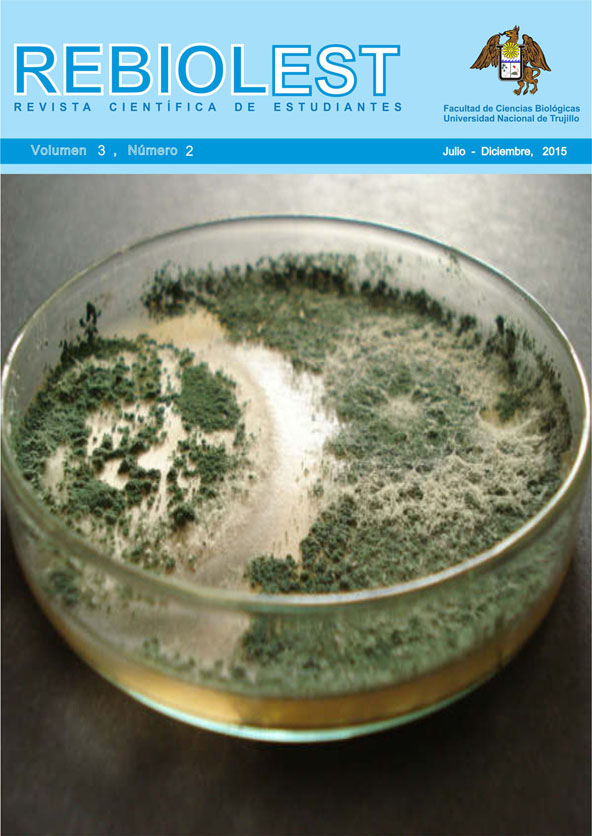Pseudomonas fluorecens de suelos agrícolas degradadora del herbicida ácido 2,4 Diclorofenoxiacético
Resumen
El 2,4-Diclorofenoxiacetico es uno de los herbicidas más usados para controlar malezas de hoja ancha, el ingrediente activo, sin embargo, tiene efectos crónicos sobre la salud humana y efectos letales sobre el suelo. Se ha demostrado que existen microorganismos que tienen la capacidad de degradar estos compuestos fenólicos, a la que se le denomina biorremediación. El objetivo de la investigación es determinar la presencia de Pseudomonas fluorecens degradadora del herbicida 2,4 D en suelos agrícolas procedentes del sector Barraza, Trujillo, Perú. Se obtuvieron muestras de suelo y de cada una se separó 10 g para efectuar diluciones, posteriormente se sembraron en agar mínimo de sales + 2,4 D y finalmente se seleccionaron colonias con diferentes morfologías. A partir de un cultivo puro se realizó la identificación basándose en su morfología cultural y característica bioquímicas, determinando la presencia de P. fluorescens degradador del 2,4 D aislada de suelos del sector Barraza-Trujillo.
Palabras clave: 2,4 D, herbicida, Pseudomona fluorecens, biorremediación, Barraza, Trujillo-Perú.
Citas
Juhler RK, Sørensen SR, Larsen L. Analysing transformation products of herbicide residues in environmental samples. Water Res. 2001; 35(6):1371–8.
Song J, Gu J, Zhai Y, Wu W, Wang H, Ruan Z, et al. Biodegradation of nicosulfuron by a Talaromyces
flavus LZM1.Bioresour Technol. 2013;140:243-8.
Chaudhry GR, Huang GH. Isolation and characterization of a new plasmid from a Flavobacterium sp.
which carries the genes for degradation of 2,4-dichlorophenoxyacetate. J Bacteriol. 1988; 170(9):3897–
Garabrant DH, Philbert MA. Review of 2,4-dichlorophenoxyacetic acid (2,4-D) epidemiology and
toxicology. Crit Rev Toxicol. 2002; 32(4):233-57.
Holland NT, Duramad P, Rothman N, Figgs LW, Blair A, Hubbard A, et al. Micronucleus frequency and proliferation in human lymphocytes after exposure to herbicide 2,4-dichlorophenoxyacetic acid in vitro and in vivo. Mutat Res - Genet Toxicol Environ Mutagen. 2002; 521(1-2):165–78.
Aksakal O, Erturk FA, Sunar S, Bozari S, Agar G. Assessment of genotoxic effects of 2,4-
dichlorophenoxyacetic acid on maize by using RAPD analysis. Ind Crops & Prod.2013; 42:552-7.
Baelum J, Jacobsen CS, Holben WE.Comparison of 16S rRNA gene phylogeny and functional tfdA gene distribution in thirty-one different 2,4-dichlorophenoxyacetic acid and 4-chloro-2-methylphenoxyacetic acid degraders. Syst Appl Microbiol. 2010; 33(2):67-70.
Marrón-Montiel E, Ruiz-Ordaz N, Rubio-Granados C, Juárez-Ramírez C, Galíndez-Mayer CJ. 2,4-D-
degrading bacterial consortium. Isolation, kinetic characterization in batch and continuous culture and application for bioaugmenting an activated sludge microbial community. Process Biochem. 2006;
(7):1521–8.
Sandoval-Carrasco CA, Ahuatzi-Chacón D, Galíndez-Mayer J, Ruiz-Ordaz N, Juárez-Ramírez C, Martínez-Jerónimo F. Biodegradation of a mixture of the herbicides ametryn, and 2,4- dichlorophenoxyacetic acid (2,4-D) in a compartmentalized biofilm reactor. Bioresour Technol. 2013;
:33-6.
Evans WC, Smith BS, Fernley HN, Davies JI. Bacterial metabolism of 2,4-dichlorophenoxyacetate.
Biochem J. 1971; 122(4):543-51.
Vedler E, Kõiv V, Heinaru A. TfdR, the LysR-type transcriptional activator, is responsible for the
activation of the tfdCB operon of Pseudomonas putida 2,4-dichlorophenoxyacetic acid degradative plasmid pEST4011. Gene. 2000; 245(1):161–8.
Greer CW, Hawari J, Samson R. Influence of environmental factors on 2,4-dichlorophenoxyacetic acid degradation by Pseudomonas cepacia isolated from peat. Arch Microbiol. 1990; 154:317–22.
Daugherty DD, Karel SF. Degradation of 2,4-Dichlorophenoxyacetic Acid by Pseudomonas cepacia DBOl
( pRO101 ) in a Dual-Substrate Chemostat. Appl Environ Microbiol. 1994; 60(9):3261–7.
Kumar A, Trefault N, Olaniran AO. Microbial degradation of 2,4 dichlorophenoxyacetic acid: Insight into the enzymes and catabolic genes involved, their regulation and biotechnological implications. Crit Rev Microbiol. 2016; 42(2):194-208.
Benndorf D, Thiersch M, Loffhagen N, Kunath C, Harms H. Pseudomonas putida KT2440 responds
specifically to chlorophenoxy herbicides and their initial metabolites. Proteomics. 2006; 6(11):3319–29.
Chaudhry, G. R., and A. N. Ali. Bacterial metabolism of carbofuran. Appl. Environ. Microbiol. 1998;
:1414-19.
Don, R. H., and J. M. Pemberton. Properties of six pesticide degradation plasmids isolated from
Alcaligenes paradoxus and Alcaligenes eutrophus. J Bacteriol. 1981; 145:681-686.
Fisher, P. R, J. Appleton, and J. M. Pemberton. Isolation and characterization of the pesticide -degrading plasmid pJP1 from Alcaligenes paradoxus. J. Bacteriol. 1978; 135:798-804.
Tiedje, J. M., J. M. Duxbury, M. Alexander, and J. E. Dawson. 2,4-D metabolism: pathway of degradation of chlorocatechols by Athrobacter sp. J. Agr. Food Chem. 1969; 17:1021-1026
Evans WC, Smith BSW, Fernley HN, Davies JI. Bacterial metabolism of 2,4 dichlorophenoxyacetate.
Biochem J. 1971; 122:543 – 551
Bhat MA, Tsuda M, Horiike K, et al. Identification and characterization of a new plasmid carrying genes for degradation of 2,4-dichlorophenoxyacetate from Pseudomonas cepacia CSV90. Appl Environ Microbiol. 1994; 60:307–12.
Chong NM, Chang HW. Plasmid as a measure of microbial degradation capacity for 2,4- dichlorophenoxyacetic acid. Bioresour Technol. 2009; 100:1174–9.

